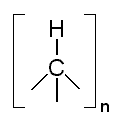.gif)
Poly(hydridocarbyne)
Encyclopedia
| Poly | |
|---|---|
| Formula | [HC]n |
| Molecular mass Molecular mass The molecular mass of a substance is the mass of one molecule of that substance, in unified atomic mass unit u... | 200,000 to 100 million Daltons |
| Melting point Melting point The melting point of a solid is the temperature at which it changes state from solid to liquid. At the melting point the solid and liquid phase exist in equilibrium. The melting point of a substance depends on pressure and is usually specified at standard atmospheric pressure... | decomposes @ 100°C |
| Boiling point Boiling point The boiling point of an element or a substance is the temperature at which the vapor pressure of the liquid equals the environmental pressure surrounding the liquid.... | N/A |
| Density Density The mass density or density of a material is defined as its mass per unit volume. The symbol most often used for density is ρ . In some cases , density is also defined as its weight per unit volume; although, this quantity is more properly called specific weight... | ??.?? g/cm³ |
| CAS number CAS registry number CAS Registry Numbersare unique numerical identifiers assigned by the "Chemical Abstracts Service" toevery chemical described in the... | ???-??-? |
| SMILES Simplified molecular input line entry specification The simplified molecular-input line-entry specification or SMILES is a specification in form of a line notation for describing the structure of chemical molecules using short ASCII strings... | ??????? |
 | |
Poly(hydridocarbyne) (PHC) is one of a class of carbon-based random network polymers primarily composed of tetrahedrally hybridized carbon atoms, each having one hydride substituent, exhibiting the generic formula [HC]n. PHC is made from bromoform
Bromoform
Bromoform is a pale yellowish liquid with a sweet odor similar to chloroform, a halomethane or haloform. Its refractive index is 1.595 . Bromoform is produced naturally by phytoplankton and seaweeds in the ocean and this is thought to be the predominant source to the environment...
, a liquid halocarbon that is commercially manufactured from methane
Methane
Methane is a chemical compound with the chemical formula . It is the simplest alkane, the principal component of natural gas, and probably the most abundant organic compound on earth. The relative abundance of methane makes it an attractive fuel...
. At room temperature, poly(hydridocarbyne) is a dark brown powder. It can be easily dissolved in a number of solvents (tetrahydrofuran
Tetrahydrofuran
Tetrahydrofuran is a colorless, water-miscible organic liquid with low viscosity at standard temperature and pressure. This heterocyclic compound has the chemical formula 4O. As one of the most polar ethers with a wide liquid range, it is a useful solvent. Its main use, however, is as a precursor...
, ether
Diethyl ether
Diethyl ether, also known as ethyl ether, simply ether, or ethoxyethane, is an organic compound in the ether class with the formula . It is a colorless, highly volatile flammable liquid with a characteristic odor...
, toluene
Toluene
Toluene, formerly known as toluol, is a clear, water-insoluble liquid with the typical smell of paint thinners. It is a mono-substituted benzene derivative, i.e., one in which a single hydrogen atom from the benzene molecule has been replaced by a univalent group, in this case CH3.It is an aromatic...
etc.), forming a colloidal suspension that is clear and non-viscous, which may then be deposited as a film or coating on various substrates. Upon thermolysis in argon
Argon
Argon is a chemical element represented by the symbol Ar. Argon has atomic number 18 and is the third element in group 18 of the periodic table . Argon is the third most common gas in the Earth's atmosphere, at 0.93%, making it more common than carbon dioxide...
at atmospheric pressure and temperatures of 110°C to 1000°C, decomposition of poly(hydridocarbyne) results in hexagonal diamond (Lonsdaleite
Lonsdaleite
Lonsdaleite , also called hexagonal diamond in reference to the crystal structure, is an allotrope of carbon with a hexagonal lattice. In nature, it forms when meteorites containing graphite strike the Earth. The great heat and stress of the impact transforms the graphite into diamond, but retains...
).
More recently poly(hydridocarbyne) has been synthesized by a much simpler method using electrolysis of chloroform
Chloroform
Chloroform is an organic compound with formula CHCl3. It is one of the four chloromethanes. The colorless, sweet-smelling, dense liquid is a trihalomethane, and is considered somewhat hazardous...
(May 2008) and hexachloroethane
Hexachloroethane
Hexachloroethane, also known as perchloroethanes , C2Cl6, is a colorless solid at room temperature which is used by the US Military in smoke compositions, e.g...
(June 2009).
The novelty of PHC (and its related polymer poly(methylsilyne)) is that the polymer may be readily fabricated into various forms (e.g. films, fibers, plates) and then thermolized into a final hexagonal diamond ceramic.

